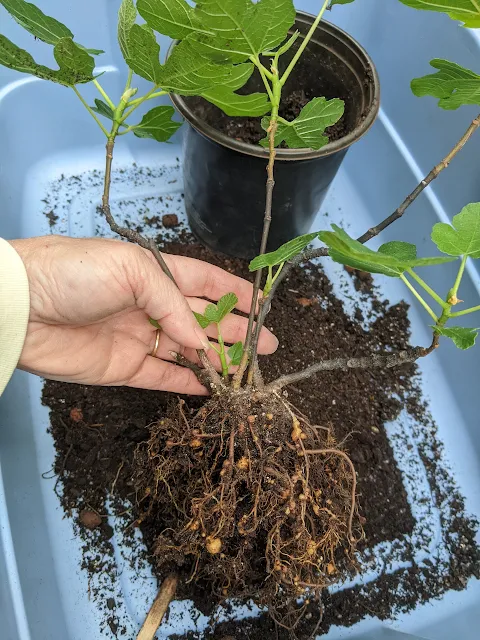Last spring, I was gifted a small Olympian fig tree. Now I've got problems. Thousands of them.
It appeared as if it had been recently dug up and potted to be given away, i.e., it didn't have a great root system and was loose in its pot. Spring turned into summer, summer into fall. Lil Figgy pushed out some small leaves but never grew bigger. It just sort of was. I worried it wasn't strong enough to make it through winter, and breathed a sign of relief when it broke dormancy. I actually was just thinking 2023 might be the creep year (out of sleep, creep, leap) but then I saw a knobby root sticking out of the soil. Digging a bit down, I saw another, and another, and then strings of them. I googled "root knots on fig" and, unlike those on legumes, these are bad.
 |
| Root-knot galls on fig tree roots. |
Root-knot galls are caused by harmful nematodes. Root Knot Nematodes (RKN) are microscopic worms that are common in sandy soils. RKN feed on roots with needle-like mouthparts, and parasitizing fig trees is a known problem. Particularly when container-grown, the root system can become damaged to the point where the plant cannot properly absorb water and nutrients.
Even though the galls harbor egg-laying adults, Lil Figgy has too many affected roots to just cut off the galls. Instead, I think the best I can do is give it clean potting mix and some nutrient-rich organic matter, something RKN do not like. Thousands of root-knot juveniles can be present in just a tablespoon of soil, so I removed as much soil as possible before repotting it. I watched a video on YouTube that gives me hope that my treatment plan will eliminate the galls.
Earthworm Castings and Neem Seed Meal
The video says worm castings are "The Cure for Nematodes" but, honestly, I have no idea how to get castings out of my Wow Worm Farm. Since I needed castings and rich organic matter, the easiest thing to do was just use finished vermicompost as is. I opened the worm bin, and as usual worms immediately retreated from the light. I fluffed up the top two inches and went to the grocery store. By the time I got back, most of the worms had burrowed down, allowing me to scoop up mostly worm-free vermicompost. I turned in some neem seed meal, another natural nematicide, and repotted the fig into a smaller pot. Now if it grows well, I'll know quickly. And when roots come out the bottom and it's ready to pot up, I'll find out if the treatment worked. My hope is to see the galls gone, and you can be sure I'll share if it does!
 |
| Olympian fig tree, freshly repotted in finished vermicompost and looking pretty good. |
The PittMoss as worm bin bedding is working really nicely. The worms process it in to a fine dark compost. Contrary to other bloggers' experience, I find torn cardboard takes a long time for the worms to break down and it constantly molds.
 |
| Fresh PittMoss bedding vs Finished compost |
My one issue with PittMoss is that it is sold in nonrecyclable plastic bags. I'm doing my best to go plastic-free so have started to collect egg cartons. If you've got a heavy-duty confetti shredder, the paper pulp bits make a great worm bedding that breaks down faster than shredded newspaper.
0 comments:
Post a Comment
Join the Conversation. Leave a comment.